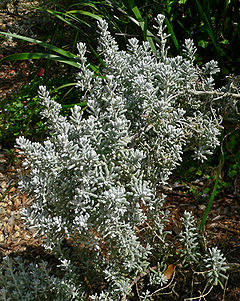
Camphorosmoideae
Encyclopedia

Amaranthaceae
The flowering plant family Amaranthaceae, the Amaranth family, contains about 176 genera and 2,400 species.- Description :Most of these species are herbs or subshrubs; very few are trees or climbers. Some species are succulent....
, formerly in family Chenopodiaceae
Chenopodiaceae
Chenopodiaceae were a family of flowering plants, also called the Goosefoot Family. They are now included within family Amaranthaceae. The vast majority of Chenopods are weeds, and many are salt and drought tolerant. A few food crops also belong to the family: spinach, beets, chard, quinoa, and...
.
Description
The members of Camphorosmoideae are mostly subshrubs or annuals. They differ from the similar SalsoloideaeSalsoloideae
The Salsoloideae is a subfamily of the Amaranthaceae, formerly in family Chenopodiaceae.- Description :These are herbs, subshrubs, shrubs and some trees. Stems and leaves are often succulent. The ovary contains a spiral embryo....
by the absence of bracteoles. Stigmas are filiform with papillae on the entire surface. The embryo is annular or folded and engirdles the perisperm. The pollen grains differ by greater diameter, and higher number of smaller pores with fewer spinulae per operculum.
Distribution
The Camphorosmoideae are distributed in Australia (ca. 147 species), Eurasia including North-Africa (ca. 27 species), South-Africa (3 species) and North-America (2 species), with a few species worldwide. They grow in steppes and semideserts.Photosynthesis pathway
The species of Chenolea-Clade and the great Sclerolaena-Clade are C3-plantsC3 carbon fixation
carbon fixation is a metabolic pathway for carbon fixation in photosynthesis. This process converts carbon dioxide and ribulose bisphosphate into 3-phosphoglycerate through the following reaction:...
. In Bassia/Camphorosma-Clade, the species are C4-plants
C4 carbon fixation
C4 carbon fixation is one of three biochemical mechanisms, along with and CAM photosynthesis, used in carbon fixation. It is named for the 4-carbon molecule present in the first product of carbon fixation in these plants, in contrast to the 3-carbon molecule products in plants. fixation is an...
, with one exception that is C3/C4-intermediate.
Evolution
The Camphorosmeae evolved in Early MioceneMiocene
The Miocene is a geological epoch of the Neogene Period and extends from about . The Miocene was named by Sir Charles Lyell. Its name comes from the Greek words and and means "less recent" because it has 18% fewer modern sea invertebrates than the Pliocene. The Miocene follows the Oligocene...
and spread from Eurasia to Australia, North America and at least two times to South Africa. The Australian lineage diversified strongly, the other lineages remained species-poor.
Genera
20 genera with about 179 species- Chenolea-Clade: with 5 disjunct species
- Chenolea Thunb., with one species
- Chenolea diffusa Thunb., in southern Africa
- Eokochia Freitag & G. Kadereit, with one species
- Eokochia saxicola (Guss.) Freitag & G. Kadereit in Central Mediterranean
- Neokochia (Ulbr.) G.L. Chu & S.C. Sand., with 2 species in southwestern North America
- Neokochia americana (S. Watson) G.L. Chu & S.C. Sand.
- Neokochia californica (S. Watson) G.L. Chu & S.C. Sand.
- Spirobassia Freitag & G. Kadereit, with one species
- Spirobassia hirsuta (L.) Freitag & G. Kadereit, from North Mediterranean to South Siberia.
- Chenolea Thunb., with one species
- Sclerolaena-Clade: with about 147 species in Australia and 3 species in Central-Asia
- Didymanthus Endl., with one species in Australa
- Dissocarpus F.Muell.,with 4 species in Australa
- EnchylaenaEnchylaenaEnchylaena is a genus of two species of small perennial shrubs endemic to Australia. Plants of this genus are commonly known as barrier saltbushes.The genus was published by Robert Brown in 1810, along with the species Enchylaena tomentosa...
R.Br., with 2 species in Australia - Eremophea PaulG.Wilson, with 2 species in Australa
- Eriochiton (R.H.Anderson) A.J.Scott, with one species in Australa
- Grubovia Freitag & G. Kadereit, with 3 species in Central-Asia
- MaireanaMaireanaMaireana is a genus of around 57 species of perennial shrubs and herbs in the family Amaranthaceae which are endemic to Australia. Species in this genus were formerly classified within the genus Kochia...
Moq., with 57 species in Australia - Malacocera R.H.Anderson, with 4 species in Australia
- Neobassia A.J.Scott, with 2 species in Australia
- Osteocarpum F.Muell., with 5 species in Australia
- Roycea C.A.Gardner, with 3 species in Australia
- Sclerolaena R.Br. (incl. Sclerochlamys F.Muell., Stelligera A.J.Scott), with 64 species in Australia
- ThrelkeldiaThrelkeldiaThrelkeldia is a genus of annuals or short-lived perennials in the family Amaranthaceae. There are two species, both of which are endemic to Australia...
R.Br., with 2 species in Australia
- Bassia/Camphorosma-Clade: widely distributed in Eurasia and southern Africa
- BassiaBassiaBassia is a plant genus of the Amaranthaceae family.-Description:The species of genus Bassia are annuals or perennial subshrubs. Their leaves are very variable and show different C4 "kochioid" types of leaf anatomy. The flowers are normally inconspicuous, in spike-like inflorescences without...
All., (Syn. Kochia, Londesia, Panderia, Kirilowia, Chenoleioides), with about 20 species, from western Mediterranean to East Asia - Camphorosma L., with 4 species, from western Mediterranean to Central Asia
- Sedobassia Freitag & G. Kadereit, with one species
- Sedobassia sedoides (Pall.) Freitag & G. Kadereit, from Hungary to Sibera
- Bassia

